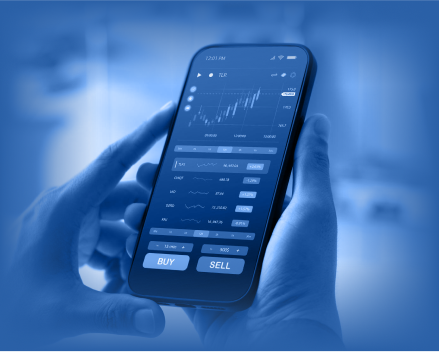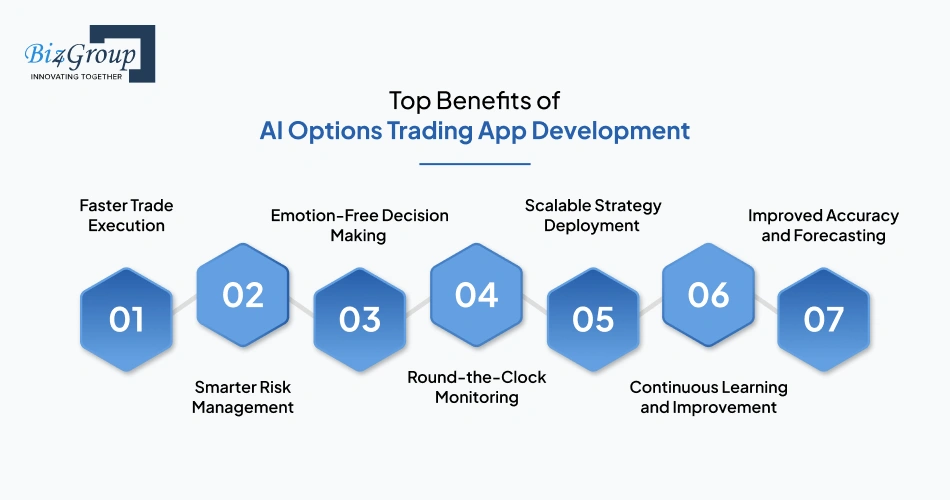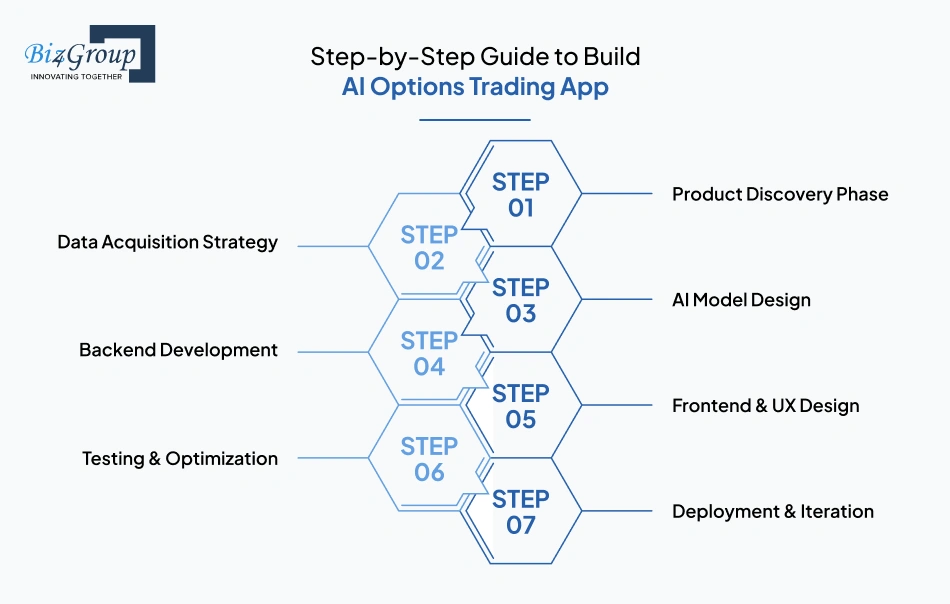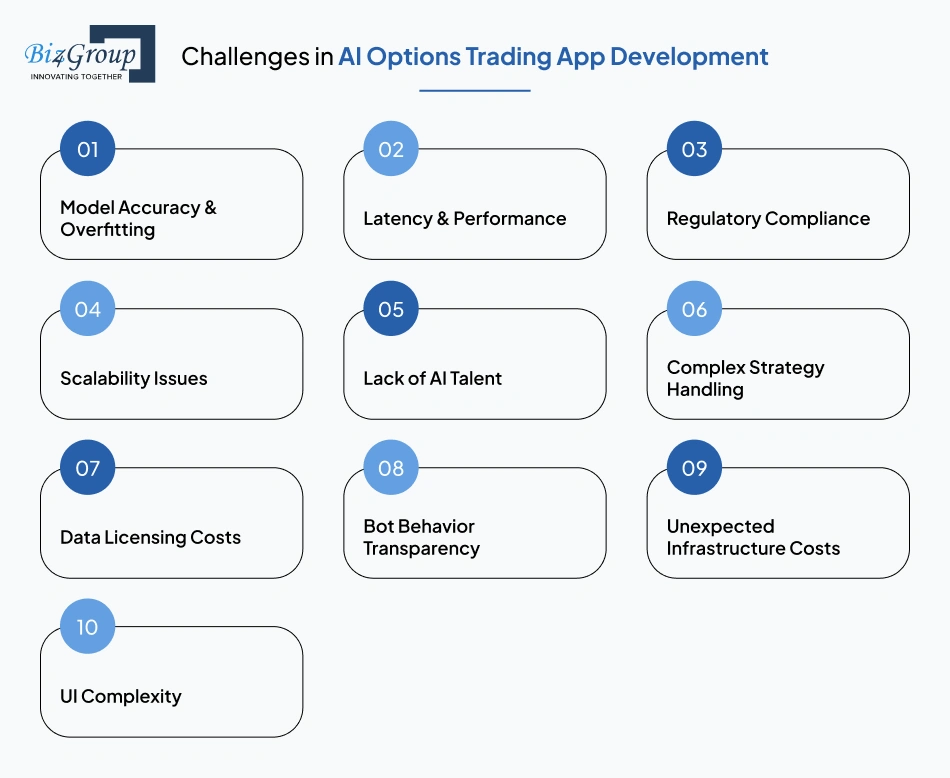Basic AI Chatbot Pricing: A simple chatbot that can answer questions about a product or service might cost around $10,000 to develop.
Read More

While your competitors are still watching the charts, their AI is already executing trades.
That’s the edge we’re talking about. The kind that doesn’t just respond to market changes but predicts them. Right now, in 2025, the firms leading the charge aren’t just trading smarter… they’re building smarter.
AI options trading app development is no longer a buzzword. It’s a boardroom mandate.
Just look at the numbers, 89% of global trades are now executed by algorithms. Meanwhile, the AI trading software market is projected to hit $13.5 billion this year.
If your trading platform or fintech product still relies solely on human speed and spreadsheet logic—you’re not just behind. You’re bleeding opportunity.
This guide is your blueprint to fix that. Whether you’re looking to build AI options trading app for proprietary desks or develop an AI-powered options trading application for retail investors, we’ll walk you through every piece of the puzzle.
You’ll discover:
This isn’t just another AI article. It’s a tactical playbook built for CTOs, fintech founders, and enterprise strategists who understand one thing:
The next wave of market winners will be built, not bought.
Let’s dive in.
Options trading involves contracts that give traders the right, but not the obligation, to buy or sell an underlying asset at a specific price before a certain date. It’s not just betting on price movement, it’s about managing risk, leveraging positions, and using volatility to your advantage.
Now, enter AI.
AI for options trading brings speed, scale, and intelligence to a traditionally manual, data-heavy process. It analyzes thousands of market variables in real time, finds patterns invisible to the human eye, and executes trades based on data, not guesswork.
This shift is at the heart of AI options trading app development, where trading strategies become smarter with every market cycle. Instead of relying on static strategies or gut instincts, firms can now leverage machine learning models that improve with every trade.
Let’s break it down.
| Traditional Options Trading | AI-Powered Options Trading |
|---|---|
|
Manual data analysis and chart reading |
Real-time analysis of vast datasets across markets |
|
Strategy based on trader experience |
Models trained on historical and real-time data |
|
Emotion-influenced decision making |
Data-driven logic with no emotional bias |
|
Delayed reactions to market movements |
Millisecond-level execution and dynamic decision making |
|
Static strategies that require constant tuning |
Self-adjusting models that adapt automatically |
The result? Better timing, reduced risk, and more consistent results, especially when built with purpose.
Partnering with a seasoned AI development company can give your team the architecture and tools needed to deploy a high-performance AI-driven trading platform without burning months on R&D.
In the next section, we’ll talk about why building this kind of solution is more than just a tech project but a strategic investment.
Let’s bring your platform into the AI era—before your competitors trade circles around you.
Talk to Our AI ExpertsIn 2025, building an AI-driven options trading app isn’t just a technological upgrade, it’s a business necessity.
The market is too fast, the data is too vast, and manual strategies can’t keep up anymore. Institutions that still rely on old-school systems are seeing performance gaps grow wider by the month.
That’s where AI options trading app development becomes a competitive weapon. By embedding intelligence directly into your trading platform, you don’t just improve decision-making—you unlock smarter automation, risk mitigation, and operational scale.
Here’s why it matters:
It’s not about replacing traders. It’s about amplifying their capabilities with systems that learn and optimize over time.
And you don’t have to build it all in-house. Partnering with a trusted trading software development company can help streamline the heavy lifting—from infrastructure to integrations.
Already have legacy systems or partial automation? Layering in modern AI automation services can instantly improve performance without a full rebuild.
Whether you’re planning to develop AI options trading app for your business or looking to productize it for end-users, the long-term gains far outweigh the upfront investment.
Because in this market, the real risk isn’t building too early, it’s waiting too long.
Next, let’s get into how these AI-powered trading apps actually work under the hood.
A well-designed trading app powered by AI does more than just place orders. It thinks, learns, and acts almost like a financial brain on autopilot.
When you invest in AI options trading app development, you're building an intelligent system that processes market data, predicts opportunities, and executes trades with speed and accuracy. Here's how each part works.
The engine starts with data. Lots of it. Your app pulls in real-time market feeds, historical options chains, economic indicators, and even alternative data like sentiment from financial news.
This step lays the foundation for AI for options trading, allowing models to learn patterns, price actions, and volatility swings at scale.
Once the data is structured, the AI model begins scanning for trade setups. It uses machine learning algorithms to identify high-probability opportunities based on technical, fundamental, and statistical signals.
If you're planning to build option trading app with AI, this is the core that determines whether your app predicts profitably or blindly guesses. Some advanced systems even integrate NLP to assess news impact or run sentiment analysis in real time.
This is where trade rules come into play. Your platform applies business logic, portfolio constraints, and risk parameters to decide whether to execute or skip a trade.
When you develop AI options trading app for your business, this layer ensures that every decision aligns with your firm's strategy. It filters out false positives and prioritizes trades that match your objectives—whether it's conservative risk or aggressive growth.
Once a trade passes all filters, it's executed via broker APIs like Alpaca, Tradier, or Interactive Brokers.
Speed is critical. The app routes orders in milliseconds, confirms fills, and logs every move for audit and analytics. If your goal is to create automated AI options trading app, this step ensures seamless performance and avoids missed entries due to human lag.
AI doesn't stop at execution. It learns from wins, losses, and every tick of data. Your system uses backtesting and real-time feedback to optimize strategies, update weights, and eliminate underperforming models.
This is the evolution part of build AI options trading app, where each trade helps the app get smarter over time.
And if you’re serious about building at scale, consider partnering with a trusted AI product development company that understands how to integrate feedback loops, reinforcement learning, and model versioning effectively.
This full-cycle process, from data to decision to learning, is what separates modern trading systems from outdated platforms.
In the next section, we’ll break down the specific benefits that come from making this leap.

When you move forward with AI options trading app development, you're not just upgrading technology. You're future proofing your trading strategy with precision, intelligence, and speed. Below are the top advantages financial firms are leveraging today.
AI detects trading signals and executes orders in milliseconds, eliminating human delay. This helps firms build AI options trading app systems that perform in real-time conditions. With automation at the core, missed trades become a thing of the past. It’s the edge every serious trader needs.
Your platform can assess volatility, exposure, and price swings across portfolios instantly. This helps develop AI options trading app for your business that responds to risk dynamically. Real-time tracking keeps losses controlled and profits optimized. It's a proactive, not reactive, approach.
AI doesn’t panic, hesitate, or chase trends. Every trade is logic-backed and strategy-aligned, which helps create automated AI options trading app solutions with consistent behavior. Removing human emotion improves accuracy long-term. Your users will trust the results more.
AI scans markets 24/7 across multiple exchanges and asset classes without fatigue. That’s key when you build a custom AI options trading application for global usage. Nothing gets missed—no matter the time zone or volatility. Your trading engine stays alert while competitors sleep.
AI allows you to test and run multiple strategies at once without adding resources. If you're working with a custom software development company, you can integrate real-time strategy A/B testing easily. Scale and adaptability are no longer technical barriers.
Every trade is feedback. AI uses results to improve and adapt its models, avoiding repetition of past errors. When you build options trading app with AI, learning becomes a built-in feature, not a future upgrade. It's a self-improving trading system from day one.
AI models recognize patterns, correlations, and volatility triggers faster than any manual method. That precision helps improve both entry and exit timing. With support from an experienced AI chatbot development company, NLP-based sentiment analysis can also be added to strengthen forecasting.
These benefits aren’t future promises—they're happening now, for platforms already ahead of the curve. The sooner you build intelligent features into your stack, the sooner your performance improves.
We build AI brains that trade smarter, faster, and with zero emotional baggage.
Schedule a Free ConsultationSmart features are what separate a basic tool from a powerful trading platform. If you’re serious about AI options trading app development, these core features need to be baked into your product from day one.
Live market data is the backbone of intelligent trading. It powers signal detection, model updates, and fast execution. To build AI options trading app that actually performs, your data pipeline must be ultra-reliable. Anything less adds risk and delays.
Traders want flexibility, not fixed templates. Let users define rules, timeframes, and entry conditions using an intuitive interface. When you develop an AI-powered options trading application, make strategy customization a core UX element. It keeps your platform adaptable and sticky.
Every strategy should be testable before going live. Backtesting against historical data helps users validate ideas and tweak models. AI in UI/UX design makes this feature easy to visualize and interpret. Simplicity drives adoption.
Smart trading is safe trading. Your app must include position sizing, stop-loss controls, and volatility filters. These features reduce exposure and increase confidence. A well-built custom AI options trading application always puts protection first.
This is where AI becomes action. Signals convert to orders and are routed to brokers instantly. Latency needs to be minimal. You can integrate APIs from Alpaca, Tradier, or IBKR. Working with a fintech software solution partner ensures your backend handles this reliably.
Your users need visibility into what’s working and what’s not. Offer P&L tracking, win/loss ratios, and trade-by-trade breakdowns. When you build options trading app with AI, make sure results aren’t a black box. Transparency builds trust.
Traders love to experiment safely. A simulated environment helps users try new strategies without risking capital. It also helps them learn the app’s capabilities. This is an underrated feature that increases onboarding success and long-term engagement.
These features lay the foundation. In the next section, we’ll dive into advanced capabilities that turn your platform from “smart” to market leading.
Modern platforms aren’t just built to trade, they’re built to think. If you want to build AI options trading app that leads the market, these are the advanced features you need to integrate.
Each one adds depth, intelligence, and real-time adaptability to your AI-powered options trading application.
| Feature | What It Does |
|---|---|
|
Predictive Analytics |
Uses machine learning to forecast price action, volatility, and sentiment shifts. Critical for teams that want to develop an AI-powered options trading application with built-in foresight. |
|
Reinforcement Learning |
Empowers your system to evolve through trial-and-error. Helps you create automated AI options trading app systems that improve with every market cycle. |
|
Sentiment Analysis |
Parses financial news and social media using NLP to detect bullish or bearish trends. A smart move when you build options trading app with AI that accounts for emotion-driven markets. |
|
AI Signal Generator |
Identifies buy/sell triggers by recognizing complex patterns in price, volume, and volatility data. A must-have in any custom AI options trading application built for precision. |
|
Smart Portfolio Allocation |
AI allocates capital based on exposure, correlation, and risk tolerance in real time. Essential when you develop AI options trading app for your business to maximize capital efficiency. |
|
Real-Time Strategy Tuning |
Allows strategies to adapt on the fly using fresh market data. Makes your AI options trading app development project dynamic, not static. |
|
Model Versioning |
Automatically promotes the highest-performing model for current market conditions. Adds reliability when you build a custom AI options trading application for enterprise use. |
|
Explainable AI (XAI) |
Shows users why a decision was made, ensuring compliance and transparency. A powerful advantage in regulated markets where trust is key. |
|
Voice-Activated Commands |
Adds hands-free control to trading tasks through AI interaction. Works seamlessly with AI chatbot integration for increased usability. |
|
Integrated AI Chatbot |
Supports user queries, assists with trade logic, and explains model decisions in plain English—perfect for enhancing your platform’s UX. |
These AI features aren't optional anymore, they're what define high-performing platforms in 2025.
If your vision is to build AI options trading app that users can trust and scale, it starts with embedding these technologies early in the process.
Up next, let’s walk through the actual step-by-step development process to make this vision real.

Creating an intelligent trading platform isn't something you piece together overnight. A successful AI options trading app development project follows a defined process—from strategy to deployment—with each step laying the groundwork for the next.
Here’s how to go from idea to execution.
This is where vision meets validation. Define your business goals, target users, and technical feasibility before writing any code.
Your AI is only as good as the data it’s trained on. Choose reliable, high-volume sources across markets and timeframes.
This step defines the intelligence layer of your platform. Choose AI models that align with your trading logic and market behavior.
Now it's time to develop an AI-powered options trading application that can execute reliably under pressure.
User experience is often the difference between adoption and abandonment. Work with a team that understands finance UI.
Before launch, stress-test every moving part. AI systems require deeper testing cycles than standard software.
Launch doesn’t mean done. Your custom AI options trading application should be built for learning and continuous improvement.
Following these steps ensures you build AI options trading app systems that aren't just functional, but scalable and intelligent from day one.
The technology you choose will define how fast, secure, and scalable your trading platform becomes. Whether you're building from scratch or modernizing an existing tool, selecting the right stack is critical for successful AI options trading app development.
Here’s a breakdown of the components and the recommended tools for each:
| Component | Recommended Technologies | Purpose |
|---|---|---|
|
Frontend Framework |
React, Vue.js |
Create fast, interactive dashboards and user-facing modules |
|
Backend Framework |
Handle logic, APIs, and integration with AI models and broker APIs |
|
|
Machine Learning Stack |
TensorFlow, PyTorch, Scikit-learn |
Build and train ML models for predictive analytics and trade decisions |
|
Data Handling |
Pandas, NumPy, Apache Kafka, PostgreSQL |
Manage real-time data streams, time-series data, and storage |
|
Broker APIs |
Alpaca, Tradier, Interactive Brokers |
Execute trades, access live market data, manage positions |
|
Cloud & Hosting |
AWS, Google Cloud, Azure |
Scalable hosting, AI model deployment, load balancing |
|
Authentication & Security |
OAuth 2.0, JWT, 2FA |
Secure login, user management, and account protection |
|
CI/CD & DevOps |
Docker, Kubernetes, GitHub Actions |
Automate testing, deployment, and model updates |
|
Monitoring & Logging |
Prometheus, ELK Stack, Datadog |
Track performance, latency, API issues, and audit trails |
|
NLP & Sentiment Analysis |
Hugging Face Transformers, spaCy |
Analyze financial news and sentiment in real time |
|
AI Model Serving |
TensorFlow Serving, TorchServe |
Deploy trained models into production efficiently |
|
UX Tools |
Figma, Adobe XD |
Design UI components before implementation |
If you're working with a custom software development company, aligning early on the tech stack ensures faster dev cycles and long-term maintainability.
Now that the tools are clear, let’s talk dollars. In the next section, we’ll break down the cost of development, what influences it, and how to estimate it accurately.
The investment to build a high-performance AI options trading app depends on your platform’s scope, AI complexity, and product vision. A simple MVP with core automation and data integration can cost anywhere from $80,000 to $120,000.
On the other hand, enterprise-grade solutions with advanced AI models, real-time execution, and full regulatory compliance can reach $250,000 or more, especially if you're integrating features like NLP, sentiment analysis, or reinforcement learning.
Other key cost drivers include:
If you're still mapping out features, consider starting with a strategic MVP development approach to validate before scaling.
For a deeper insight into what influences costs, deployment options, and hidden expenses, refer to our detailed breakdown here: cost to develop AI options trading app
And if you're comparing build-from-scratch vs ready-made solutions, this guide on how much it costs to build a trading platform using AI offers a side-by-side look.
Planning your budget right is the first smart trade you’ll make.
We help you build smart, scalable AI trading apps—without blowing your budget.
Get a Custom Quote
No project comes without bumps. Developing a smart trading platform with AI introduces a unique mix of technical, strategic, and compliance challenges. Below is a breakdown of common issues and how to solve them while building your AI options trading app.
| Challenge | Why It Happens | Solution |
|---|---|---|
|
Model Accuracy & Overfitting |
AI models often become too specific to historical data and fail in live markets |
Use diverse datasets, apply dropout/regularization, and continuously retrain models |
|
Latency & Performance |
Slow data feeds or order execution can kill profit potential |
Optimize backend with fast APIs, caching, and lightweight models |
|
Regulatory Compliance |
SEC and FINRA guidelines require transparency and audit trails |
Implement explainable AI (XAI), proper logging, and compliance-ready features |
|
Scalability Issues |
Poor architecture can break under real-time loads |
Use microservices, cloud-native design, and modular code |
|
Lack of AI Talent |
Finding qualified AI developers is expensive and time-consuming |
Partner with firms or hire AI developers who specialize in trading AI apps |
|
Complex Strategy Handling |
User-defined strategies with custom rules are hard to manage without bloat |
Build flexible rule engines with real-time validation and visual strategy editors |
|
Data Licensing Costs |
Real-time market data often requires expensive third-party licenses |
Start with free APIs for MVP, negotiate commercial licenses as you scale |
|
Bot Behavior Transparency |
Users want to understand why the system made a trade |
Integrate AI explainer modules, or refer to AI trading agent logic models |
|
Unexpected Infrastructure Costs |
AI workloads scale fast—so do your bills |
Monitor usage, and consider edge computing or containerization to control cost |
|
UI Complexity |
Financial tools are often data-heavy and hard to navigate |
Work with design-led teams and check proven products like AI stock trading app for UX references |
Overcoming these challenges early leads to smoother launches and better user adoption. Planning with resilience in mind makes your custom AI options trading application more competitive from day one.
If you’re aiming to launch a next-gen AI options trading app, you need more than coders. You need strategic builders who understand how AI thinks, how traders behave, and how markets evolve.
That’s where Biz4Group delivers.
We’re not one of those firms that need months just to understand the difference between IV rank and implied volatility crush. Our team already speaks the language of derivatives, data science, and decision engines—and that fluency shows in every product we touch.
We’ve helped fintech companies build AI options trading apps from concept to launch that are now scaling globally.
Whether your goal is to launch a retail-facing platform or create a private AI-powered options trading application for high-volume traders, we bring clarity, speed, and AI muscle to your vision.
What sets us apart?
We’ve also worked with clients building niche tools like AI forex trading bots, grid trading bot development, and even NFT-based trading platforms—so we know how to handle multi-layered builds.
If you're looking to develop AI options trading app for your business that stands out in speed, scale, and sharpness—Biz4Group is who tech-first finance teams call when it’s time to stop prototyping and start performing.
Let’s take your trading platform from smart to unstoppable.
Top fintechs trust Biz4Group to build the future of AI trading. Ready to lead the pack?
Let’s Build Something SmartAI is no longer a value-add in trading—it’s the baseline. Firms that embrace intelligent automation are already dominating faster markets, reducing risk exposure, and scaling with precision. If you haven’t started planning your AI options trading app development, you're already playing catch-up.
Platforms that build AI options trading app systems with predictive modeling, smart execution, and dynamic risk engines aren't just outperforming—they're redefining what trading success looks like.
Whether your goal is to develop AI options trading app for your business, launch a productized solution, or build internal tools that outperform the market, the opportunity is real and immediate.
But execution is everything.
That’s why fintech innovators choose Biz4Group. As a trusted trading software development company, we bring the perfect mix of AI expertise, financial intelligence, and scalable architecture to every project.
Our experience spans use cases across verticals—from designing AI crypto trading bot systems that trade around the clock to helping enterprises figure out how much it costs to build a trading platform using AI. We’ve earned our reputation not just by building fast, but by building platforms that last.
If you're ready to create a platform that learns, adapts, and performs—let’s talk.
Because in this space, timing matters. And your timing couldn’t be better.
The average cost to develop an AI options trading app for your business ranges from $80,000 to $250,000 or more, depending on complexity and features. For real-world benchmarks and pricing structures, see our breakdown on enterprise AI chatbot development cost, which follows similar infrastructure and security needs.
When you build AI options trading app solutions, make sure to include real-time data ingestion, predictive analytics, AI signal generation, risk controls, and a backtesting engine. Platforms that scale usually combine both core and advanced features like NLP, portfolio rebalancing, and explainable AI.
Timelines depend on scope. An MVP can take 10–14 weeks, while full-featured enterprise apps may require 5–7 months. If you’re modeling after mature platforms, explore what the top trading app development companies in USA are delivering in terms of speed and quality.
Yes, AI can be integrated into legacy systems without a full rebuild. Whether it’s adding predictive modeling or intelligent alerts, integration depends on backend architecture. Use cases are similar to how enhancements are handled in forex trading app platforms with dynamic market data layers.
AI offers speed, objectivity, and 24/7 analysis. Unlike manual methods, it continuously learns and improves using real-time data. That’s why most innovators now prefer to build options trading app with AI instead of relying solely on human traders.
Yes, it must be. A properly built AI options trading app should follow regulatory frameworks (like SEC or FINRA), implement data encryption, and include audit trails and explainable AI to ensure transparency and accountability.
Biz4Group is recognized among the top 15 trading software development companies in USA. We help financial firms build custom AI options trading applications with smart automation, scalable design, and lightning-fast execution logic.
with Biz4Group today!
Our website require some cookies to function properly. Read our privacy policy to know more.